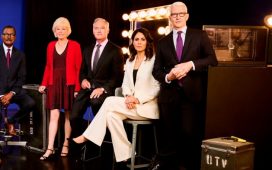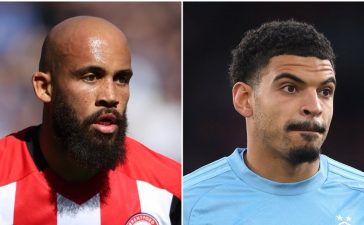Australia’s men’s cricket team won the World Test Championship Final against India at The Oval in June. But that success was eclipsed by an animated match played by dogs with plastic bats and a tennis ball.
The test final coincided with the launch of the Bluey episode “Cricket”, in which a kelpie puppy called Rusty upstages the increasingly bemused adult dog characters with his batting prowess.
International cricket has reliably attracted huge television audiences in Australia for decades. But Bluey’s match attracted 563,000 viewers compared with the peak audience of 524,000 for a real game that Australia was winning.
The meteoric rise of Bluey — a cheerfully idiosyncratic 2D animated series about a suburban family of blue heelers, or cattle dogs, in Brisbane — has surprised many in the animation industry. It has become a global hit in a competitive genre largely dominated by comic book franchises and high-end computer generated imagery.

The antics of the Heeler family — which range from psychedelic episodes about dreams to courtroom-style dramas over accusations of flatulence — were first aired in Australia in 2018. The show has since been exported to 60 countries, including the UK and China.
It soon became the number one rated show on the BBC children’s channel CBeebies. In the US, where it is streamed on Disney+, it was the most streamed show of any genre in early December, accounting for 918mn minutes of viewing in one week, according to rating agency Nielsen.
For a country best known for low-grade soap operas, which relies on exports of commodities like iron ore, red meat and coal for its economic resilience, the global success of the cartoon is a “source of national pride”, says Jim Chalmers, Australia’s treasurer.
“For generations of people right around the world, Bluey will be the first thing they learn about Australia and that’s incredibly powerful,” Chalmers, who is from Brisbane, says. “Bluey’s brilliance is not just as an export but as a symbol of Australia. Nothing says Australia quite like Bluey.”
Australia has deep connections to the global media industry due to A-list actors including Margot Robbie and Chris Hemsworth and as a location for international productions such as The Matrix, Thor: Ragnarok and the Netflix series Clickbait. Australian director Baz Luhrmann shot his Elvis biopic in Queensland, where Bluey is made.
But rarely has a show that is so unapologetically Australian captivated worldwide audiences.
One of the surprising things about Bluey’s success, says Matthew Deaner, chief executive of the Screen Producers Australia trade body, is that countries like the US have embraced a show featuring Australian accents and idioms, as well as storylines based on things like cricket.

That puts Bluey in the same camp as the hit 1980s film Crocodile Dundee, Barry Humphries’ Dame Edna Everage character and the Men At Work’s song “Down Under” as cultural exports that are distinctively Australian that have broken through overseas.
Bluey has opened the door for newer Australian shows, says Deaner, like the comedies Colin From Accounts and Fisk, which have started to have an impact overseas despite being developed for the local market.
“It feels like we’ve won the World Cup of content and [the show] is a great harmony of local and international success. Bluey shows [Australia] is fertile soil and that lots can be planted here,” he says.
Bluey is the creation of Joe Brumm, an animator who spent a decade in the UK working on children’s shows including Peppa Pig before returning to Queensland to raise his family.
Brumm considered making the show as an adult cartoon. But he settled instead for stories largely based on his own experiences as a parent of two daughters.
One storyline contrasts the adult dogs struggling to construct flat-pack furniture while the children create their own adventure using the discarded boxes and bubble wrap. Another tackles how to convince kids to throw away excess toys.
Cyrine Amor, senior analyst at media research company Ampere Analysis, says Bluey stands out in the children’s market due to the quality of its scripts. “The plots are low stakes, cheerful and very appealing to parents as well as children, which contributes to its huge popularity,” she says.

The cricket episode, while ostensibly about sport, culminates in the precocious Rusty deliberately hitting a catch to his younger sister who his father, a soldier stationed overseas, has told him to look out for.
Moments like that are key to why Bluey works, according to its creators. On the Behind Bluey podcast, hosted by Brumm, the director of the cricket episode, Richard Jeffrey, said: “Little moments like [the catch], when you get them right, they really hit you. That’s when you feel like, man, we’re not just making a cartoon here, we are telling a story.”
Chris Oliver-Taylor, chief content officer for the Australian broadcaster ABC, also points to the cricket episode as achieving a level of poignancy alongside its humour that elevates the show to an emotional place other cartoons struggle to reach. “That’s a special magic,” he says.
The emphasis on character, script and an ability to subtly cover heavier themes — including depression, infertility and parental peer pressure — makes the show stand out among content that is often formulaic and hypnotic in its style.

Nimrod Avraham Ray, a cartoon developer, argues that positive and emotive stories that allow younger viewers to feel good about themselves are cutting through in an era defined by Covid-19, conflict and climate change. “The world outside is like a horror movie,” he says. Bluey’s sitcom-like family humour and its emphasis on kindness and unity makes it ideal for difficult times, Ray adds.
Bluey’s animation style gives the cartoon a more authentic, hand-drawn feel compared with the high-end CGI-based shows that have come to dominate children’s entertainment, adds Ray. His show God’s Gang adopts a similar approach, harking back to the animation of the 1970s when shows like Scooby Doo captured a sense of fun. “The bottom line is to make people feel good just like Bluey,” he says.
The blue heeler breed first emerged in the 1800s when farmers needed a dog able to control cattle herds grazing over vast distances. The genealogy of what’s commonly known as the Australian Cattle Dog — which comes in red or blue colours and has a distinctive mask — has been traced in part to the native dingo.
For Arthur and Cheryl Edwards, who have bred cattle dogs for 50 years in the Waterfall region south of Sydney, the animal is one of Australia’s finest inventions alongside Holden cars and Hills Hoist washing lines. They are also one of the country’s most enduring exports, with puppies leaving for Europe and North America since the 1940s.
Yet the cartoon Bluey bears little resemblance to the original model. “Farmers designed the dog and you wouldn’t go within 10 feet of it. They’d kill you. They took shit from no one,” Arthur says.
The success of the cartoon has created a problem within the breeding industry, says Arthur, with unscrupulous sellers taking advantage of unsuitable owners who are desperate to buy their kids a Bluey. “I wouldn’t sell a dog for A$100,000 to the wrong person,” he says. “People haven’t got a clue. They’re soft on the dogs and they can get out of control. There are way too many in the pound.”
The enthusiasm for blue heelers has gone far beyond the dogs themselves. More than 1,000 products featuring the dog family’s likeness have been made, ranging from books to plush toys to toothpaste. A video game was launched last month and the character will make its British stage debut in December as the travelling Bluey Big Play. The television show, which relies on the voice of Australian indie band Custard’s singer Dave McCormack for much of its humour, has even achieved a number one hit album in the country.

The Bluey cottage industry is transforming a part of north Brisbane, which will open a 4,000 square metre “immersive space” modelled on the Heeler family’s house and garden in August. Queensland, home to the Great Barrier Reef, is banking on an A$18mn boost in visitor spending once Bluey’s World opens.
It is not the first Australian children’s show to make waves overseas. In the 1960s, Skippy the Bush Kangaroo was broadcast in more than 150 countries. Modern titles such as Bananas in Pyjamas, Round the Twist, Hi-5 and band The Wiggles have all proved popular with children outside Australia.
“Bluey didn’t land out of nowhere,” says Oliver-Taylor. “She was built on the back of 70 to 100 shows.”
Ben Willee, general manager at media company Spinach Advertising, pointed to The Wiggles — the children’s music group that is one of the country’s most successful international acts alongside AC/DC — as evidence of the commercial potential of Australia’s children’s entertainment market. “It’s not seen as cool but there’s a lot of money there,” he says.
The scale of Bluey’s success has nonetheless set a new bar for what Australian content can do on the global stage. “It shows we can capture the world’s imagination,” he adds.
For all Bluey’s soft power potential, the ABC is currently not the broadcaster making money out of the show’s success worldwide.
Bluey is made by independent company Ludo Studios and was originally funded by government film agencies before it was co-commissioned by the ABC and BBC Studios, the British broadcaster’s commercial arm.
In 2017 the BBC attained broadcasting rights for the show globally, bar Australia, and licensing and merchandising rights worldwide, Australia included. It has been a major growth driver. The cartoon was singled out in the BBC’s annual report for 2023 as a significant factor in its 28 per cent increase in revenue to £2bn for the year and a 10 per cent rise in consumer product sales.
The ABC, which broadcasts the show in Australia, has defended itself against accusations that it missed out on securing the lucrative rights to the country’s golden goose. David Anderson, the ABC’s managing director, has argued that Bluey is a “priceless” show that has brought joy to children around the world. “Who knew it was going to be a unicorn,” he said last month on ABC radio.
Ludo’s decision to partner with public sector broadcasters, as opposed to a streaming giant or private equity-backed media developer, may have contributed to the show’s success.

Larger, commercially-oriented companies could have taken creative control away from Brumm and Ludo, says Deaner. “The magic could have been kicked out of it and the wealth transferred to a global business. Screen content is a combination of art and commerce. You need to get both working the same way.”
Vast sums of money have flooded into the children’s entertainment market — which accounts for around 5 per cent of global television commissioned, according to Ampere — as media companies, private equity investors and toy makers have targeted a segment that once was once seen as the preserve of public sector broadcasters.
Peppa Pig’s owner, Entertainment One, was sold to Hasbro for £3.3bn in 2019. Blackstone backed two former Disney executives in 2021 to launch Candle Media, which has spent more than $4bn on deals to acquire children’s content, including UK producer Moonbug which makes CocoMelon.
A move to develop films based on toys including Transformers, Barbie dolls and Lego bricks has also proved lucrative for studios.
Yet signs of strain have started to show. Disney and Netflix have cut investment dramatically while Moonbug has started to cut jobs and scale back production, according to a report by Bloomberg.

Amor says there has been a steeper reduction in children’s TV commissions in 2023 compared with other genres. Animation, which is time consuming, complex and costly to make, has been hit especially hard by budget cuts. “From the streamers’ perspective, while kids’ shows can be considered a good investment for churn-reduction — most parents wouldn’t dare to unsubscribe if their kids are enjoying a platform’s content — they are generally less of a subscription driver than high-end series aimed at adults,” she says.
With companies looking for “safe bets” to invest in, Bluey has a “huge advantage”, according to Amor.
Oliver-Taylor adds that there is uncertainty over how much new content is really needed given the best shows are timeless and that children are migrating to TikTok and Instagram at a younger age. That makes it a tough landscape for producers attempting to target children’s entertainment with new brands.
“If we set out to make half a billion dollars by creating a new Bluey then we’d fail,” he says. “For all [the show’s] success, it’s lightning in a bottle.”
This article has been corrected since publication to reflect the fact that Australia’s men’s cricket team beat India at The Oval in June, not at Lord’s










